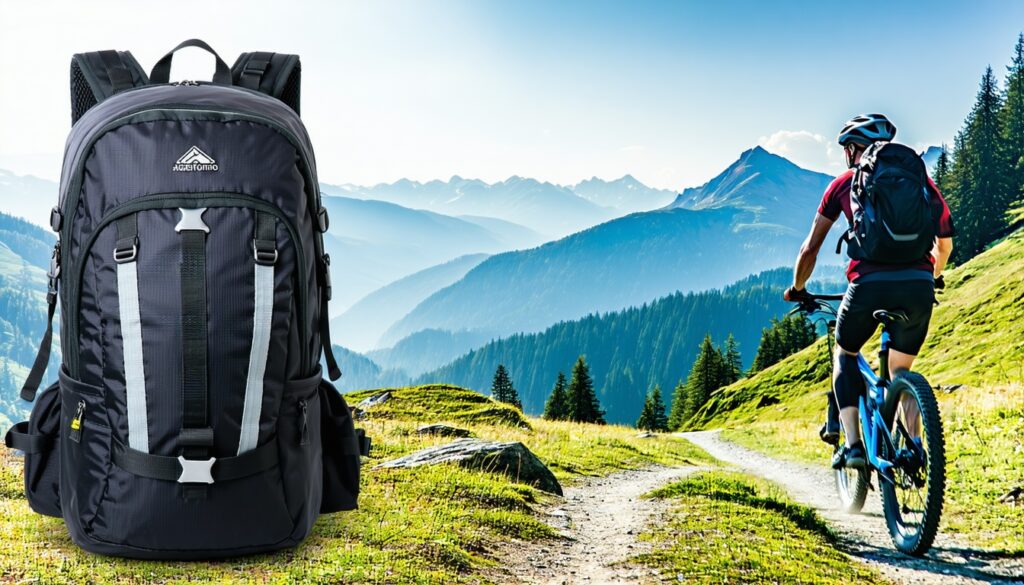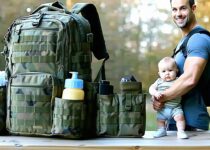Most Durable Cycling Backpacks for Mountain Bikers

Essential Items for Mountain Biking
In order to enjoy a successful ride on the trails, it’s essential for mountain bikers to be well-prepared. This section focuses on two key aspects of preparation: tools and repair kits, as well as hydration and nutrition.
Tools and Repair Kits
Having the right tools and repair kits can make all the difference in the event of a malfunction during a ride. A reliable multi-tool, such as the Crank Brothers Multi-19, is a must-have. This versatile tool can be used for tightening bolts, adjusting rear derailleurs, and fixing broken chains along the trail. It’s often considered an essential item for any mountain bike pack [Two Wheeled Wanderer].
Another critical item is a master chain link. Chains are prone to breaking when riding, and being prepared with a master link and a multi-tool that includes a chain breaker can save a ride from going downhill fast.
| Tool/Kit Item | Purpose |
|---|---|
| Multi-Tool | Tightens bolts, adjusts derailleurs, repairs chains |
| Master Chain Link | Essential if the chain breaks |
Hydration and Nutrition
Staying properly nourished and hydrated is crucial for mountain bikers. Carrying enough water and snacks is critical, especially for rides that last longer or occur in hotter conditions. Electrolyte tabs, like SaltStick Fast Chews, are highly recommended to help maintain hydration on those grueling days.
Mountain bike backpacks are designed to support hydration on the go. Many backpacks come equipped with integrated hydration systems, featuring water reservoirs and easy-to-use drinking tubes. This design allows cyclists to drink without having to stop, which is vital for endurance and performance during long rides.
| Hydration Item | Description |
|---|---|
| Water Reservoir | Holds water for drinking during rides |
| Drinking Tube | Allows for easy sipping without stopping |
| Electrolyte Tabs | Helps in maintaining hydration during long rides |
Selecting the appropriate tools and ensuring adequate hydration and nutrition are just the first steps in preparing for a mountain biking adventure. With organized storage in the right cycling backpack, riders can feel confident tackling the trails. For further insights on choosing the best pack for these purposes, be sure to explore related articles on hydration-compatible cycling backpacks: what to look for and how to pack tools snacks and gear in a bike backpack.
Must-Have Accessories for the Trail
Cyclists embarking on a mountain biking adventure should be prepared for any situation. Having the right accessories can make a significant difference in ensuring a smooth ride. Here are three essential items every mountain biker should carry on the trail.
Hand Pump
A hand pump is an essential tool for mountain bikers. It allows riders to adjust tire pressure or inflate new tubes when facing a flat. Cyclists can choose between pumps that are CO2 cartridge compatible or traditional pumps, depending on personal preferences and convenience. Many models are compact enough to fit into a backpack without taking up much space, making them highly practical for on-the-go repairs.
| Feature | Description |
|---|---|
| Type | Hand or CO2 cartridge compatible |
| Size | Compact for easy carrying |
| Use | Inflate tires or tubes |
For more tips on comfortably fitting your gear, read our article on how to choose an ergonomic cycling backpack for comfort and posture.
Tubeless Tire Plug Kit
For mountain bikers using tubeless tires, carrying a tubeless tire plug kit is highly recommended. These kits include plugs that can seal tire holes in seconds, eliminating the need to carry inner tubes. This is especially useful for quick fixes on the trail, enabling riders to continue their adventure without lengthy delays.
| Feature | Description |
|---|---|
| Type | Tubeless tire plug with multiple plugs |
| Use | Quickly seals holes in tires |
| Advantage | Eliminates the need for tubes |
To learn more about tire maintenance, check out our guide on best practices for organizing your gear in a bike backpack.
Master Chain Link
Chains can break unexpectedly on the trail, making a master chain link an important component to carry. This accessory, paired with a multi-tool that includes a chain breaker, serves as a lifesaver in case of a breakdown. Having a master link allows riders to quickly reconnect their chain and get back on the trail.
| Feature | Description |
|---|---|
| Type | Master link for chain repair |
| Use | Quick reattachment of broken chains |
| Essential | Vital for emergencies while riding |
For more information on maintaining your bike equipment, refer to our article on using a cycling backpack for bikepacking weekend trips.
These must-have accessories enhance the biking experience and provide security against possible mechanical issues on the trail. Considering the unpredictability of mountain biking, being prepared can lead to a more enjoyable ride.
Top Cycling Backpack Recommendations
Finding the right cycling backpack can enhance the mountain biking experience. Below are three top recommendations that cater to different needs and preferences.
Osprey Raptor 10 and Raven 10
Osprey’s Raptor 10 and women’s-specific Raven 10 are celebrated for their versatile and comfortable design. Each pack features a capacity of 10 liters, making them practical for various rides. They include a high-quality 2.5-liter Hydraulics LT reservoir, which provides an excellent hydration solution. Additionally, they offer a best-in-class helmet carry option and solid construction for durability.
| Feature | Details |
|---|---|
| Capacity | 10 liters |
| Reservoir | 2.5-liter Hydraulics LT |
| Price | $165 |
| Key Features | Helmet carry, comfortable fit, durable materials |
Though generally praised, some users have reported issues with the hydration hose magnet attachment and the accessibility of hipbelt pockets. For more insights on choosing cycling backpacks, see our article on how to choose an ergonomic cycling backpack for comfort and posture.
Osprey Katari 7
The Osprey Katari 7 is an affordable choice priced at $90. It provides ample water-carrying capacity alongside the essentials needed for rides. The pack is available in three sizes: 1.5L, 3L, and 7L.
| Feature | Details |
|---|---|
| Capacity | 7 liters |
| Price | $90 |
| Key Features | Lightweight, suitable for essentials, flexible sizes |
However, some testers noted that the lack of structure can lead to concentrated weight on the shoulders instead of being evenly distributed, which might cause discomfort during longer rides. For tips on proper fit and adjustment, check our article on how sternum and waist straps improve stability on the bike.
Dakine Seeker 6L
The Dakine Seeker 6L is recognized as an excellent waist pack for mountain biking, with a price tag of $125. It is designed for short rides and features a well-organized storage layout.
| Feature | Details |
|---|---|
| Capacity | 6 liters |
| Reservoir | 2-liter HydraPak |
| Price | $125 |
| Key Features | Internal storage, hipbelt pockets, external compression straps |
Some riders may find the design a bit pricey for its capacity, and waist packs can pose limitations compared to traditional backpacks. For insights on the advantages of different backpack designs, read about cycling backpacks vs rack pannier: pros & cons.
These cycling backpacks cater to varying levels of biking needs, ensuring cyclists can find one that suits their riding style and requirements.
Best High-Capacity Cycling Backpacks
For mountain bikers who require extra storage on their rides, high-capacity cycling backpacks are essential. Here are some of the top recommendations that provide both durability and ample space.
Patagonia Dirt Roamer 20L
The Patagonia Dirt Roamer 20L is designed for mountain bikers seeking durability and storage. With a capacity of 20 liters, it accommodates essential gear, snacks, and hydration systems. Made from tough materials, this backpack is built to withstand rough trails while keeping your belongings secure.
| Feature | Specification |
|---|---|
| Capacity | 20 liters |
| Material | Durable fabric |
| Hydration Compatible | Yes |
| Weight | Approximately 1.5 lbs |
Evoc Trail Pro 10
The Evoc Trail Pro 10 is another great option, offering the ideal balance of storage and lightweight design. Its 10-liter capacity is perfect for carrying essentials without feeling bulky on the trail. This backpack includes compartments for organizing tools and a specially designed pocket for a hydration bladder.
| Feature | Specification |
|---|---|
| Capacity | 10 liters |
| Material | Water-resistant |
| Hydration Compatible | Yes |
| Additional Features | Tool pocket |
CamelBak M.U.L.E. Pro
The CamelBak M.U.L.E. Pro stands out as one of the best overall options for mountain biking. With an 11-liter capacity, it features a 3-liter CRUX Reservoir providing easy hydration access during rides. The Air Support Pro Back Panel enhances ventilation, making it comfortable for long rides.
| Feature | Specification |
|---|---|
| Capacity | 11 liters |
| Reservoir | 3 liters CRUX |
| Ventilation | 3D Vent Mesh |
| Weight | Approximately 2 lbs |
These backpacks are among the most durable cycling backpacks for mountain bikers, blending practicality with comfort. When considering which one to choose, think about your specific riding needs, storage requirements, and the type of terrain you’ll encounter. For more information on hydration solutions, check out our guide on hydration-compatible cycling backpacks: what to look for.
Specialized Mountain Biking Backpacks
Selecting the right backpack for mountain biking is essential for enhancing the riding experience. Below are some of the specialized backpacks that stand out for their design and features.
POC Column VPD Backpack 8L
The POC Column VPD Backpack 8L is ideal for downhill biking, notable for its CE EN 1621-2 Level 1 back protector. This feature adds an extra layer of safety, making it perfect for those looking to tackle more challenging terrains. The lightweight design includes divided organizing pockets and 3D mesh ventilation to keep riders comfortable. It also supports hydration bladders up to 3L, though it’s worth mentioning that the bladder is not included. Additionally, some users have pointed out that the limited space for gear organization could be a downside for those needing to carry multiple items. More detailed reviews can be found at Treeline Review.
| Feature | Specification |
|---|---|
| Capacity | 8L |
| Back Protector | CE EN 1621-2 Level 1 |
| Hydration Bladder Compatibility | Up to 3L |
| Ventilation | 3D mesh ventilation |
Osprey Siskin 8 and Salida 8
The Osprey Siskin 8 for men and Osprey Salida 8 for women are both considered top choices among small mountain bike packs. Each offers 8 liters of capacity and comes with a 2.5-liter Hydraulics LT reservoir for hydration. They feature well-designed pockets for gear organization and effective Airscape ventilation systems to keep the rider cool. Both packs also include an adjustable LidLock helmet system, providing a secure place for the helmet when not in use. However, some users have noted a plastic taste when drinking from the hydration bladder, which may be a consideration for some.
| Model | Capacity | Hydration Reservoir | Key Features |
|---|---|---|---|
| Osprey Siskin 8 | 8L | 2.5L | Airscape ventilation, LidLock system |
| Osprey Salida 8 | 8L | 2.5L | Airscape ventilation, LidLock system |
For more on hydration options, explore our article on hydration-compatible cycling backpacks: what to look for.
Gregory Endo and AVOS
The Gregory Endo and AVOS are recognized as some of the best adjustable fit mountain bike packs available, featuring a generous 15 liters of capacity and a 3-liter 3D Hydro Reservoir. Both packs come with a Shift RS Adjustable Stability Belt, making it easy to find the perfect fit for various body types. They boast excellent organization capabilities, with mesh gear pockets and fleece-lined pouches. Additionally, they include easy-stow tool rolls for convenience on the go. Riders have appreciated the comfortable back ventilation and overall organization features.
| Model | Capacity | Hydration Reservoir | Adjustability Feature |
|---|---|---|---|
| Gregory Endo | 15L | 3L | Shift RS Adjustable Belt |
| AVOS | 15L | 3L | Shift RS Adjustable Belt |
For tips on how to fit your cycling backpack, check out our article on how to choose an ergonomic cycling backpack for comfort and posture.
Choosing specialized backpacks tailored for mountain biking can greatly enhance comfort, safety, and organization while out on the trails.
Features of Mountain Bike Backpacks
Choosing the right mountain bike backpack involves understanding its features that cater specifically to cyclists. Organization and storage, along with weight distribution and stability, are key aspects to consider for an efficient and comfortable ride.
Organization and Storage
Most mountain bike backpacks are designed to provide ample storage for essential gear such as tools, snacks, and hydration bladders. They often feature multiple compartments, allowing cyclists to organize their belongings efficiently for quick access during rides.
| Backpack Volume | Typical Uses |
|---|---|
| 10L – 20L | Day trips, hydration, food |
| 30L | Multi-day adventures, extra gear |
Popular models include the CamelBak M.U.L.E. Pro (14 liters) and the Osprey Syncro 20 (20 liters), which cater to different storage needs, from basic day bags to more substantial capacity backpacks for extended trips. Mountain bike backpacks are generally equipped to hold spare tubes, tools for repairs, snacks, first aid kits, and protective gear. This organization helps mountain bikers manage their gear effectively without adding unnecessary bulk.
Weight Distribution and Stability
The design of mountain bike backpacks emphasizes stability, which is crucial for maintaining balance on rough terrains. Features like adjustable, padded shoulder straps, chest straps, and narrow hip belts help distribute the weight evenly across the body. This thoughtful design reduces fatigue and distractions, making for a more enjoyable ride on challenging trails.
Additionally, some backpacks are built with durable, abrasion-resistant materials to withstand the rigors associated with close contact to rocks, branches, and other obstacles. For those who value extra safety, some models even include integrated back protectors, adding another level of security during rides.
Understanding these features helps cyclists find the most durable cycling backpacks for mountain bikers, ensuring they have the right pack for the journey ahead. For more insights on how to choose a comfortable backpack, check out our article on how to choose an ergonomic cycling backpack for comfort and posture.
Ventilation and Durability
When choosing the most durable cycling backpacks for mountain bikers, ventilation and durability are two essential features that can make a significant difference during rides. Mountain biking often involves challenging terrains and prolonged physical activity, making these qualities crucial for comfort and performance.
Breathable Back Panels
Breathable back panels are designed to enhance airflow and reduce moisture buildup, ensuring that the rider stays cool and comfortable, especially during hot summer rides. These panels can feature air channels or mesh padding that encourages ventilation. A backpack with excellent breathability can help prevent sweat accumulation, ultimately making the riding experience more enjoyable.
| Feature | Description |
|---|---|
| Ventilation Type | Air channels / mesh padding |
| Benefits | Enhances airflow & comfort, minimizes moisture buildup |
For more information about why ventilated back panels matter in cycling backpacks, check out our article on why ventilated back panel matters in a cycling backpack.
Abrasion-Resistant Materials
Durability is paramount for mountain biking backpacks, given that they are often subjected to rigorous conditions such as close contact with branches, rocks, and rough surfaces. Most backpacks in this category are constructed from durable, abrasion-resistant materials that provide long-lasting use. Some models even incorporate integrated back protectors, ensuring rider safety in case of falls.
| Material | Advantages |
|---|---|
| Abrasion-Resistant Fabric | Stands up to rough surfaces, reduces wear and tear |
| Integrated Back Protectors | Adds safety and protection for the spine |
These robust materials not only extend the lifespan of the backpack but also help maintain the integrity of stored gear, making them a vital feature for adventurous cyclists. If you’re considering hydration options, be sure to look into hydration-compatible cycling backpacks: what to look for for optimal performance while on the trail.
Adjusting and Using MTB Backpacks
Choosing and using the right mountain bike backpack requires understanding how to properly adjust it for comfort and stability. It also opens the door to alternative options that can better meet a cyclist’s specific needs.
Fit and Adjustment Tips
When fitting an MTB backpack, it’s important to ensure it fits snugly against the body without being too tight. The right adjustment helps in maintaining balance and reduces fatigue during long rides. Here are some key tips for adjusting your backpack:
-
Back Length Adjustment: Set the back length of the backpack to fit your torso. Most models have an adjustable harness to accommodate different body shapes.
-
Hip Belt Tightening: Secure the hip belt to help distribute the weight evenly across your hips. This reduces strain on the shoulders and back.
-
Shoulder and Chest Straps: Adjust the shoulder straps to ensure they hold the backpack close to your body. A properly adjusted chest strap adds extra stability, preventing the pack from shifting as you ride.
Alternative Backpack Options
For cyclists seeking alternatives to traditional mountain biking backpacks, several options can provide specialized comfort or utility.
| Option | Description | Ideal For |
|---|---|---|
| Hydration packs | Lightweight packs designed primarily for hydration, often including a water reservoir and tube. | Short rides or when minimal gear is needed. |
| Roll-top backpacks | These feature a roll-top closure for easy access and adjustable capacity, making them versatile for various riding scenarios. | Riders needing expandable storage for urban cycling or commuting (should you use a roll‑top backpack for urban cycling?). |
| Panniers | Attach directly to a bike rack, offering ample storage for longer rides without the strain on your back. | Bike touring or carrying larger loads. |
| Seat bags | Compact bags that attach under the seat, suitable for carrying small essential tools or snacks. | Riders who want minimal disruption and weight. |
Choosing the right backpack involves considering your specific riding habits and preferences. To ensure maximum comfort, refer to our guide on how to choose an ergonomic cycling backpack for comfort and posture.


